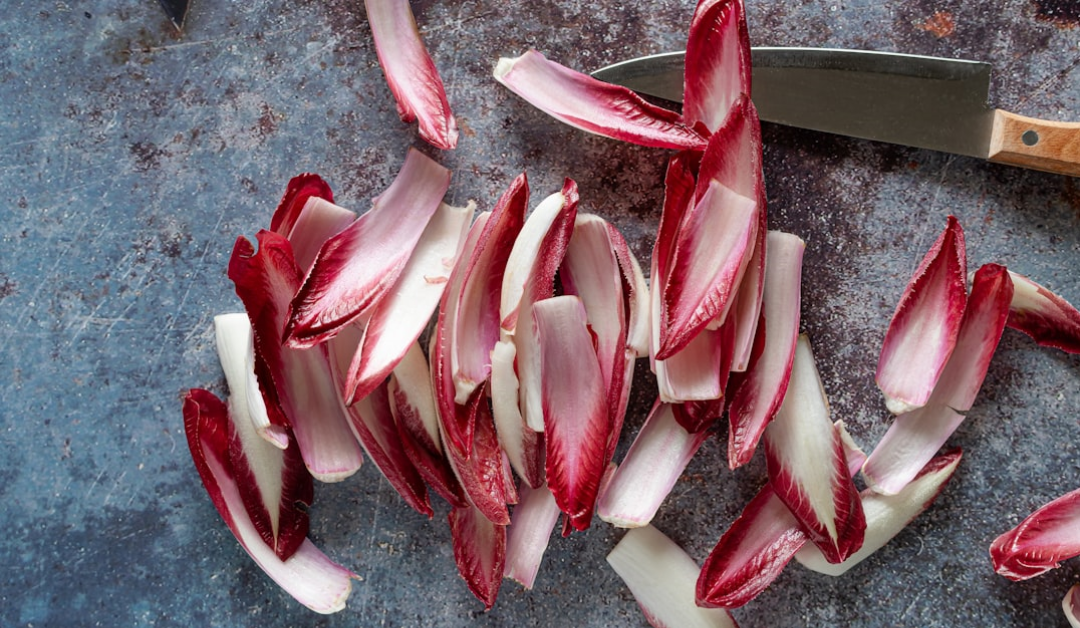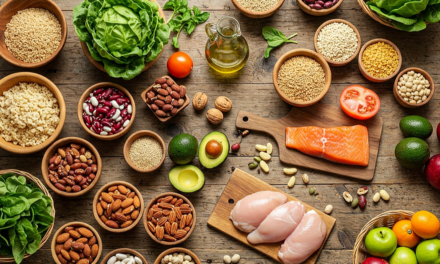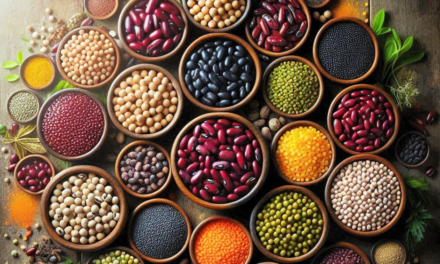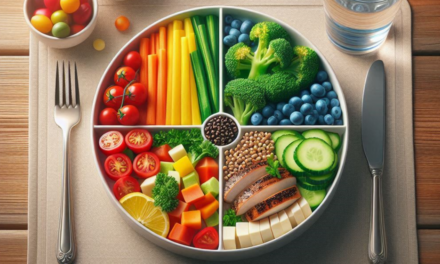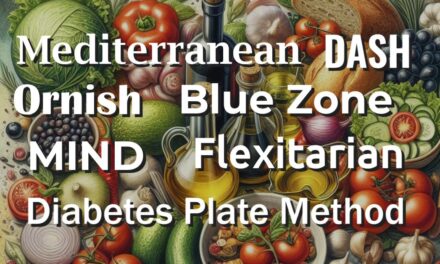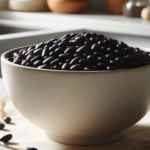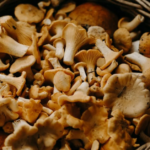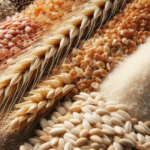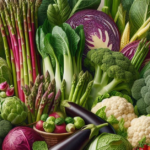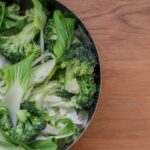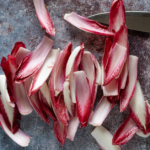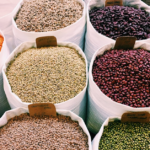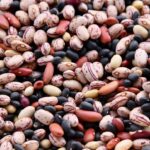The publication calendar already had a post about the health benefits of endive (pronounced on-deev) scheduled, but then I came across America’s Heartland – Episode 6, which featured Rich Collins, the founder of California Endive Farms in Rio Vista, California. The largest Endive grower in the United States is California Endive Farms. Watching the show inspired me to research endive further and publish the article today.
The show explored how growing endive involves a two-step process: an initial growth phase in the field and a forcing phase in controlled conditions. The initial phase requires careful soil preparation, proper spacing, and consistent care. The roots are then harvested and stored before being forced to produce chicons in a dark, cool environment. This meticulous and time consuming process ensures the production of high-quality endive, which is known for its crisp texture and mildly bitter flavor.
It turns out endive, a versatile and nutrient-rich leafy green, offers a remarkable array of health benefits that make it an invaluable addition to a diabetic diet. With its ability to aid in weight management, regulate blood sugar levels, and provide a wealth of essential vitamins and minerals, endive emerges as a true “diabetic delight.”
Diverse Varieties: A World of Possibilities
Endive comes in different varieties, each offering unique flavors and culinary applications.
Curly endive: In addition to its robust and crisp texture, curly endive also offers a slightly bitter and peppery flavor, which adds a unique and refreshing element to salads. The deeply cut, narrow, and curly leaves create an attractive and eye-catching appearance, making it a popular choice for garnishing dishes.
The sturdy nature of curly endive allows it to hold up well to dressings, ensuring that it remains crisp and crunchy even when mixed with other ingredients. This makes it an excellent choice for salads that require some time to marinate or for those that will be served at picnics or potlucks. Furthermore, curly endive is rich in vitamins A and K, as well as fiber, making it a nutritious addition to any salad.
Escarole: This type of leafy green vegetable, is known for its broad, slightly curved leaves and mild flavor. This versatile green is a popular choice for pairing with savory dishes like soups and stews. Its tender leaves add a delightful texture to these hearty dishes while its milder flavor complements the rich and savory flavors of the broth or sauce.
Whether added raw to a soup for a refreshing crunch or cooked down in a stew for added depth, escarole brings a delightful balance to these dishes. Additionally, the slightly bitter undertones of escarole can help cut through the richness of the dish, providing a pleasant contrast. Its versatility and ability to enhance the flavors of savory dishes make escarole a favorite among many cooks and chefs.
Belgian or French endive: Also known as Witloof chicory, it is a leafy vegetable that is characterized by its pale color and tightly packed leaves. It has a unique flavor profile, offering a delicate and slightly sweet taste. When cooked, the sweetness of the endive becomes even more pronounced, making it a versatile ingredient in various dishes. Its crisp texture holds up well to cooking methods such as grilling, braising, or roasting, allowing it to be used in a wide range of recipes.
Served as a side dish, incorporated into salads, or used as a main ingredient in gratins or stir-fries, Belgian or French endive adds a subtle yet distinct flavor that enhances the overall taste of the dish.
Exploring these diverse varieties allows individuals with diabetes to tailor endive to their specific dietary needs and taste preferences.
The Nutrient-Dense Powerhouse
Endive is a low-calorie, nutrient-dense vegetable that packs a punch in terms of health benefits. Its impressive nutrient profile includes essential vitamins like A, C, and K, as well as a host of minerals. The high water content of endive promotes hydration, an essential aspect of overall health, especially for those managing diabetes. In addition, the significant presence of vitamin K in endive plays a vital role in maintaining healthy blood clotting, thereby decreasing the risk of excessive bleeding, which can be problematic for people living with diabetes.
Here are the nutrition facts for one cup of Endives.
- Calories: 8-9 calories
- Total Fat: 0.1g
- Saturated Fat: 0.02g
- Cholesterol: 0mg
- Sodium: 11mg
- Total Carbohydrates: 1.7g
- Dietary Fiber: 1.6g
- Total Sugars: 0.13g
- Protein: 0.6-0.63g
- Vitamin C: 3.3mg (4% DV)
- Vitamin K: 115.5mcg (96% DV)
- Folate: 71mcg (18% DV)
- Calcium: 26mg (2% DV)
- Iron: 0.42mg (2% DV)
- Potassium: 157mg (3% DV)
Regulating Blood Sugar Levels
One of the most significant advantages of endive for those of us with diabetes is its ability to help regulate blood sugar levels. With its low glycemic index and high fiber content, endive can help prevent rapid spikes and crashes in blood sugar levels after meals, promoting better glucose control. The fiber in endive slows down the absorption of sugar into the bloodstream, ensuring a steady release of glucose, a crucial factor in diabetes management.
Versatile Culinary Applications
Endive’s versatility extends beyond its nutritional benefits, offering a wide range of culinary possibilities for those of us with diabetes. From crisp and refreshing salads to hearty soups and stews, we can incorporate endive into various dishes, adding depth of flavor and texture. Its compatibility with the ketogenic diet plan further enhances its appeal, making it a valuable addition to diabetic-friendly meal planning.
Here are some diabetes-friendly recipe ideas that include endive:
Endive Salad with Pears and Walnuts
– Thinly slice endive and toss with sliced pears, toasted walnuts, and a vinaigrette made with olive oil and balsamic vinegar.
– Endive is low in carbs, while pears and walnuts provide fiber and healthy fats to help regulate blood sugar.[1][2]
Endive Boats with Tuna Salad
– Use endive leaves as “boats” and fill them with a tuna salad made with canned tuna, diced celery, Greek yogurt, and lemon juice.
– This provides protein from the tuna and is low in carbs thanks to the endive.[1]
Roasted Endive with Parmesan
– Cut endive heads in half, drizzle with olive oil, and roast until tender.
– Top with grated Parmesan cheese before serving.
– Roasting brings out endive’s natural sweetness while keeping it low-carb.[2]
Belgian Endive Gratin
– Layer endive leaves in a baking dish with a mixture of eggs, cream/milk, and Gruyère cheese.
– Bake until set for a tasty vegetable casserole. Use low-fat dairy to reduce calories.[2]
The bitterness of endive combined with ingredients like fruit, nuts, cheese, and lean proteins makes it a flavorful choice for diabetics looking to increase vegetable intake while managing blood sugar levels.
Proper Preparation and Storage
To get the most out of endive, it is important to prepare and store it correctly. Thoroughly washing the leaves under cold running water and patting them dry with a clean towel is recommended. Once clean, endive can be stored in the refrigerator in an airtight container or plastic bag to maintain its crispness and freshness.
Endive’s versatility lends itself to a wide range of cooking approaches, from grilling to sautéing, and even using it as a low-carb wrap alternative. Experimenting with different cooking techniques and flavor pairings can unlock a world of possibilities, allowing folks with diabetes to enjoy endive in various dishes while reaping its nutritional benefits.
Potential Considerations and Drawbacks
While endive offers numerous advantages for individuals with diabetes, it’s crucial to be mindful of potential drawbacks, such as allergic reactions or interactions with certain medications.
Consulting with a healthcare professional is advisable for those taking blood thinners, as endive contains a high concentration of vitamin K, which can affect blood clotting.
Raw vs. Cooked: The Nutritional Debate
The decision to eat endive raw or cooked can impact its nutritional value. Raw endive retains more water-soluble vitamins, like vitamin C, while cooking can enhance its flavor and improve digestibility for those with sensitive digestive systems.
Ultimately, the choice depends on individual preferences and dietary requirements, allowing individuals with diabetes to tailor their endive consumption to their specific needs.
The Takeaway
In conclusion, endive stands as a true “diabetic delight,” offering a wealth of health benefits and culinary possibilities for individuals managing diabetes. With its ability to regulate blood sugar levels, provide essential nutrients, and adapt to various cooking methods and dietary plans, endive emerges as a versatile ally in promoting overall well-being. By embracing this nutrient-dense leafy green and exploring its diverse applications, individuals with diabetes can elevate their culinary experiences while supporting their health and effectively managing their condition.
Recipe Citations:
[1] https://discover.texasrealfood.com/diabetes-diet-decoder/endive
[2] https://midiabetecooking.com/en/recipe-endives-and-ham-gratin-low-gi/
###
Remember, proactive self-care matters. Every step we take, every decision we make to better manage our diabetes makes a difference in how well and how long we live. Choose wisely. Live long, love life and be well.
The information on this site is not intended or implied to be a substitute for professional medical advice, diagnosis or treatment. The information on this site is for informational purposes only and is not intended to diagnose, treat, or cure any type of disease or condition. Diabetes Control Today does not guarantee any results for your specific situation. In support of our website, we may share resources offered by trusted partners. If you purchase products from any of these partners, the owners of this site may receive a portion of the proceeds. These affiliations allow us to continue bringing you valuable, potentially life-changing content.

